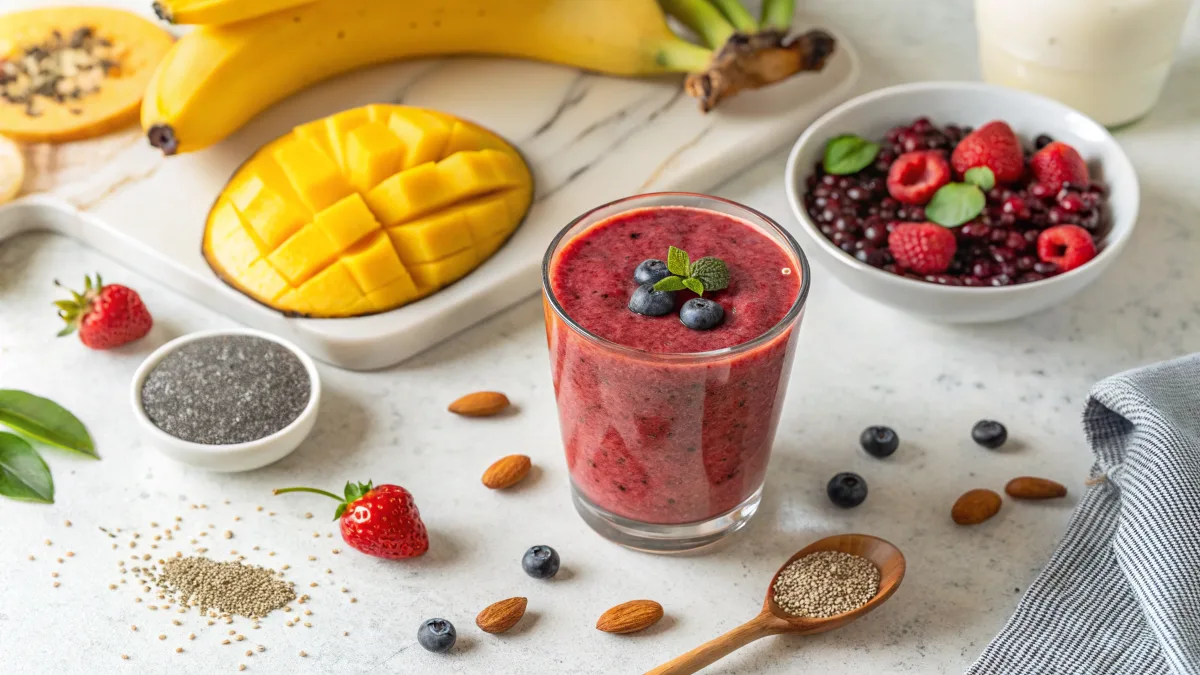Fruit smoothies no yogurt are quickly becoming a favorite among health-conscious eaters, vegans, and those with dairy sensitivities. They offer all the creamy texture and fruity goodness of traditional smoothies—without the dairy. Whether you’re looking to avoid lactose, reduce animal-based products, or simply explore new flavors, there are countless ways to enjoy delicious smoothies without yogurt.
This article will walk you through why people are ditching yogurt, what ingredients work best for creamy texture, and how to build smoothies that are tasty, nutritious, and totally dairy-free. We’ll also cover tips, recipe ideas, and answer the most common questions about making fruit smoothies no yogurt. By the end, you’ll be ready to blend like a pro—no yogurt needed.
Table of Contents
Why Choose Fruit Smoothies Without Yogurt?
Health Benefits of Going Dairy-Free

One of the biggest reasons people turn to fruit smoothies no yogurt is the desire to avoid dairy. Lactose intolerance affects millions of Americans, leading to symptoms like bloating, cramping, and digestive distress after consuming milk or yogurt. Smoothies are meant to make you feel energized and light—not sluggish and uncomfortable.
Removing yogurt doesn’t mean sacrificing creaminess or nutrition. In fact, many people report improved digestion, fewer breakouts, and reduced inflammation after cutting out dairy. Dairy is also a known trigger for skin conditions like acne and eczema in some individuals. By choosing a yogurt-free smoothie, you allow your body to operate more smoothly without those added stressors.
Heart health is another win. Many traditional yogurt-based smoothies contain saturated fats that can raise cholesterol levels. Swapping yogurt for plant-based options significantly reduces saturated fat intake and boosts your intake of fiber, vitamins, and minerals—especially when using whole fruits and seeds as thickening agents.
More people are now searching for simple recipes for fruit smoothies no yogurt that taste amazing and deliver a similar (if not better) nutritional profile.
Dietary Reasons for Avoiding Yogurt
Beyond health, there are many dietary preferences that make fruit smoothies no yogurt a go-to choice. Vegans, of course, avoid all animal products including yogurt. Paleo and Whole30 followers skip dairy to focus on unprocessed, ancestral foods. Others may avoid dairy for religious or ethical reasons.
Then there are concerns about added sugar in commercial yogurt products. Even “healthy” flavored yogurts can have up to 20 grams of added sugar per serving, which turns a smoothie into a dessert. That’s not what you want when you’re aiming for a nutritious start to the day.
One of the main benefits of fruit smoothies no yogurt is how easy they are to customize. You control the ingredients, sweetness level, and consistency—without relying on dairy.
And let’s face it: some folks just don’t like yogurt. The tangy flavor or texture can be a turn-off, especially for kids. Luckily, plant-based alternatives allow for rich, creamy, delicious smoothies with zero compromise.
By embracing fruit smoothies no yogurt, you’re not just following a trend—you’re making a smart, sustainable, and delicious change.
Start your journey toward better health with our deep dive into smoothie nutrients, where you’ll uncover how to craft smoothies that work for your body and lifestyle.
Essential Ingredients for Creamy Fruit Smoothies Without Yogurt
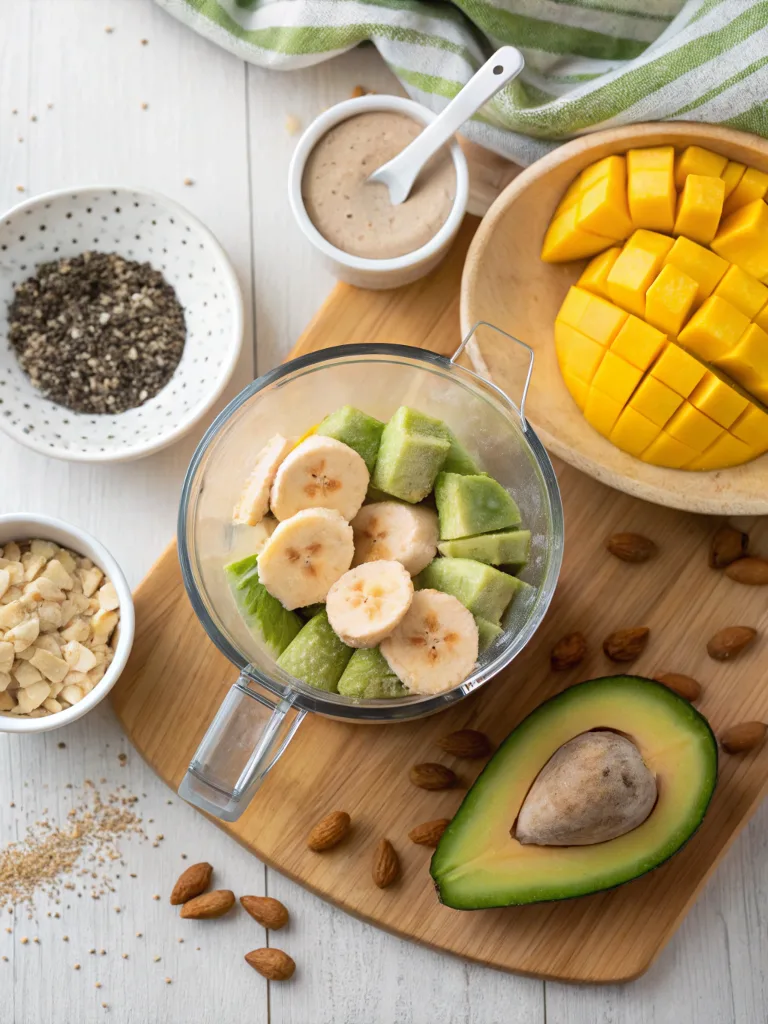
Best Fruits for a Creamy Texture
When making fruit smoothies no yogurt, one of the first challenges is replacing the creamy texture usually provided by yogurt. Luckily, Mother Nature delivers.
Here are the best fruits to give you that thick, rich, satisfying texture:
| Fruit | Benefits | Texture & Flavor |
|---|---|---|
| Bananas | High in potassium, naturally creamy | Smooth, mild, sweet |
| Mango | Rich in vitamin C and antioxidants | Thick, tropical |
| Avocado | Healthy fats, fiber-rich | Velvety, neutral |
| Papaya | Aids digestion | Silky, tropical |
| Frozen berries | High in fiber and antioxidants | Thick when frozen |
| Pear | Hydrating and soft | Smooth, subtle sweetness |
| Dates | Natural sweetener, rich in fiber | Sticky, caramel-like |
Bananas are the MVPs. They’re cheap, always available, and freeze well. Frozen bananas especially create a texture that rivals any dairy-based smoothie. Mangoes and papayas lend a tropical, luxurious creaminess. Avocados add richness with heart-healthy fats and very little flavor—perfect for blending.
When making fruit smoothies no yogurt, the right fruit combination really matters. Consider mixing frozen mango with banana, or papaya with pear, to hit both flavor and texture goals.
A common misconception is that fruit smoothies no yogurt are watery or bland. But using the right fruit combinations proves otherwise.
Healthy Plant-Based Thickeners
If fruit alone doesn’t get you to the desired thickness, try adding one or more plant-based thickeners:
| Ingredient | Benefits | How to Use |
|---|---|---|
| Chia seeds | Fiber, omega-3s, protein | Soak in water for 5–10 min |
| Ground flaxseed | Hormone-balancing, fiber-rich | Add 1 tbsp per smoothie |
| Oats | Long-lasting energy, thick texture | Use rolled or soaked oats |
| Silken tofu | High protein, blends well | Add 1/4 cup per blend |
| Nut butters | Protein, healthy fats | 1 tbsp almond or peanut |
| Cooked sweet potato | Vitamins A, C, potassium | Use 1/2 cup mashed |
| Frozen cauliflower | Low-carb, neutral taste | Adds creamy bulk |
There are dozens of creative ways to blend fruit smoothies no yogurt using pantry staples like oats and seeds. Soaked chia seeds develop a gel-like texture. Tofu is especially useful for post-workout smoothies that need extra protein.
For those watching their diet, fruit smoothies no yogurt are a great low-calorie alternative to those packed with high-fat dairy.
Our featured recipe, Smoothie Recipes Without Yogurt, combines great taste with targeted nutrition to help you stay energized throughout your day.
Best Liquid Bases for Fruit Smoothies Without Yogurt
Almond Milk, Oat Milk, Coconut Milk, and More
You can easily prep ingredients for fruit smoothies no yogurt in advance for busy mornings. But liquid choice is crucial. It affects texture, flavor, and nutrition.
| Liquid Base | Taste Profile | Texture | Best Pairings |
|---|---|---|---|
| Almond Milk | Nutty, subtle | Light | Berries, bananas |
| Oat Milk | Naturally sweet | Creamy | Cinnamon, apple, mango |
| Coconut Milk | Tropical, rich | Thick | Pineapple, mango, papaya |
| Cashew Milk | Buttery, neutral | Ultra creamy | Chocolate, cherry, banana |
| Soy Milk | Neutral | Creamy | Protein-rich smoothies |
| Coconut Water | Slightly sweet | Watery | Post-workout hydration |
The texture of fruit smoothies no yogurt often surprises people with how rich and velvety they can be. Especially when paired with the right liquid base.
Comparing Taste and Nutrition of Each Base
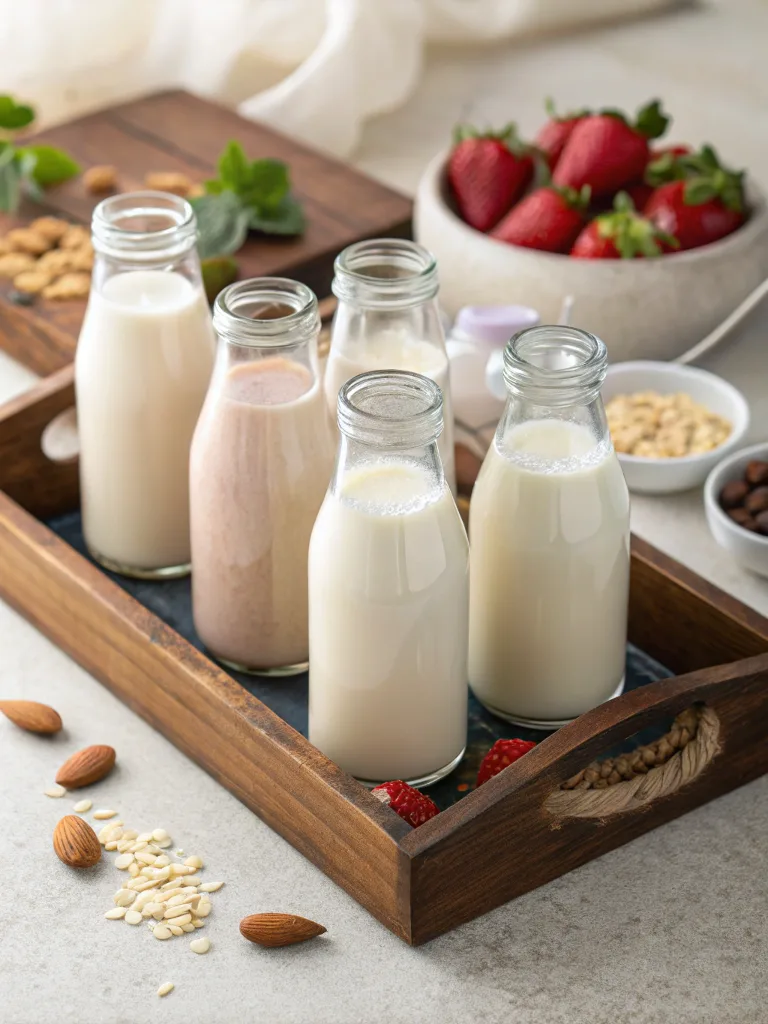
Let’s break down nutrition and best use:
| Milk Type | Calories (1 cup) | Protein | Good For |
|---|---|---|---|
| Almond | 30–50 | 1g | Low-cal blends |
| Oat | 90–120 | 2–4g | Creamy breakfast smoothies |
| Coconut | 45–100 | <1g | Tropical smoothie bases |
| Cashew | 40–60 | 1g | Dessert-inspired smoothies |
| Soy | 80–100 | 7–10g | High-protein, post-workout blends |
Some athletes prefer fruit smoothies no yogurt made with soy milk to get that protein boost.
Smoothie King Angel Food Recipe stands out not only for its taste but also for the way it balances nutrients to deliver lasting energy and satisfaction.
Best Substitutes for Yogurt in Smoothies
Nut Butters, Avocado, Bananas
Nut butters are rich, flavorful, and nutrient-dense. Almond, peanut, cashew—they’re all great choices. Just one tablespoon adds body and staying power.
Bananas are your go-to for sweetness and silkiness. Frozen bananas, especially, create thick, milkshake-like results in fruit smoothies no yogurt.
Avocados offer healthy fats and a buttery texture, and they’re perfect when you want a neutral-tasting thickener.
Whether you’re new to blending or a smoothie pro, making fruit smoothies no yogurt is simple and satisfying when you know what to include.
Chia Seeds, Silken Tofu, Soaked Oats
Chia seeds expand and create a pudding-like consistency. Flaxseed is similar, with the bonus of hormone-balancing lignans.
Silken tofu blends smoothly and is flavorless. It’s ideal for protein-rich smoothies.
Soaked oats thicken blends naturally and offer complex carbs for long-lasting energy.
Frozen cauliflower is another stealthy hero: it disappears into the smoothie but adds creaminess and volume.
Explore how Tropical Smoothie Sunrise Sunset blends delicious ingredients with functional benefits to support your wellness goals.
Explore how Bahama Mama Tropical Smoothie blends delicious ingredients with functional benefits to support your wellness goals.
Simple Fruit Smoothie Recipes Without Yogurt
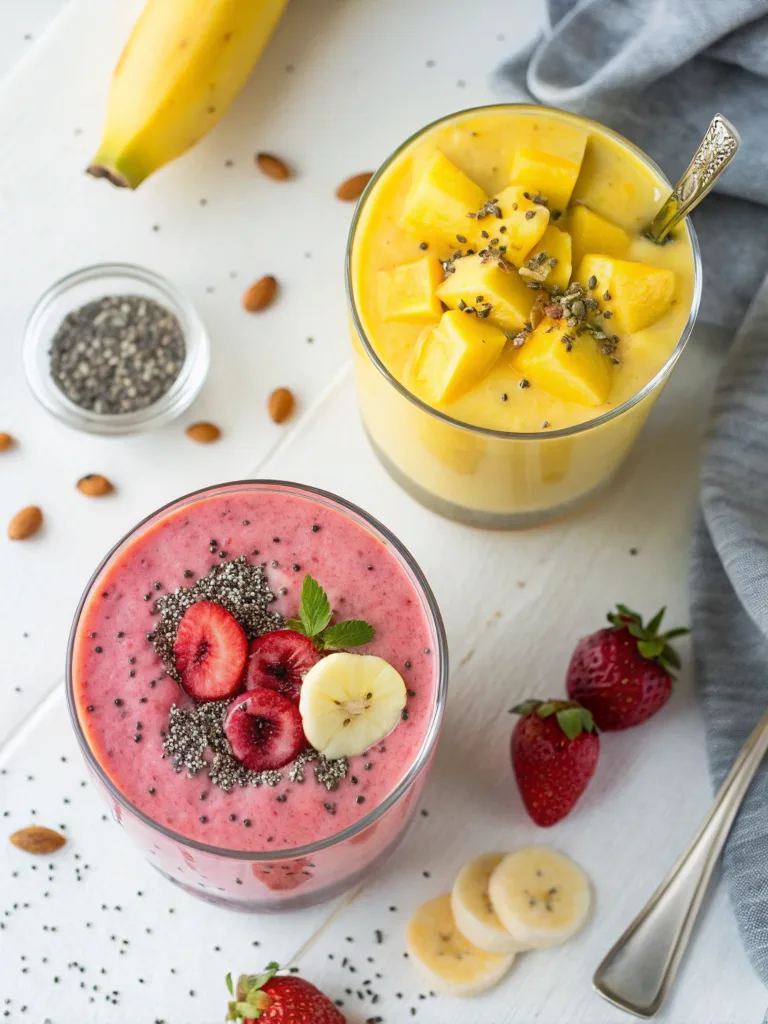
Banana-Berry Smoothie Without Yogurt
Meal preppers love making fruit smoothies no yogurt in batches to save time.
Ingredients:
- 1 frozen banana
- 1 cup mixed berries
- 1 tbsp almond butter
- 1/2 cup oat milk
- 1 tbsp ground flaxseed
Instructions:
- Blend everything until smooth.
- Adjust liquid for preferred thickness.
- Serve immediately or refrigerate.
Tropical Mango-Pineapple Smoothie With Coconut Milk
Fruit smoothies no yogurt work well in any season, whether you’re cooling off or warming up with spiced fruit blends.
Ingredients:
- 1 cup frozen mango
- 1/2 cup frozen pineapple
- 1/2 ripe avocado
- 3/4 cup coconut milk
- 1 tsp chia seeds (optional)
Instructions:
- Blend until creamy.
- Pour and enjoy—preferably with a tropical playlist.
Smoothie Meal Replacement stands out not only for its taste but also for the way it balances nutrients to deliver lasting energy and satisfaction.
Tips to Make Your Smoothies Extra Creamy Without Yogurt
Blending Techniques That Matter
Believe it or not, how you blend makes a world of difference. Making fruit smoothies no yogurt starts with a strategic blending approach that affects everything from texture to taste. Always begin with your liquid base first. This ensures that heavier items don’t clog the blades, and the ingredients blend evenly. Follow that with soft fruits like bananas or avocado, then frozen items, and finally, seeds or thickening agents.
Use a high-powered blender if you can. Devices like Vitamix or Blendtec handle frozen fruits and dense ingredients better, resulting in an ultra-smooth finish. If your blender isn’t quite as strong, consider letting frozen ingredients thaw slightly before blending. It’ll save your motor and still yield that creamy texture you want.
Another underrated trick? Pulse blending. Start slow, then increase the speed to avoid trapping air bubbles or leaving chunks behind. Stirring between blends can also help distribute ingredients more evenly. This process gives you the dreamy consistency you’d expect from a yogurt-based smoothie, only without the dairy.
Many beginners are surprised by how thick and luscious fruit smoothies no yogurt turn out when blended properly. A good blender technique often makes the difference between a watery blend and a rich, spoon-worthy smoothie.
Freezing and Layering Ingredients for Texture
One of the best things you can do to level up your smoothies is to use frozen ingredients intentionally. Not only do they add that chill-factor you love, but they also enhance the body of your smoothie. Frozen bananas, mango chunks, berries, and even frozen cauliflower or zucchini (yes, really!) are excellent ways to create creamy textures naturally.
For example, freezing oat milk into cubes and blending them can thicken your smoothie without watering it down like ice would. You can also pre-freeze soaked oats, silken tofu portions, or avocado slices in freezer-safe containers to make daily smoothie prep a breeze.
Layering is another essential tip when building fruit smoothies no yogurt. Always put the liquids first, then soft fruits, then hard or frozen items, and finally add-ins like chia seeds or nut butters. This layering order ensures your blender doesn’t jam and blends everything smoothly.
Some pro smoothie makers even like to blend in two phases: first the base and fruits, then add the boosters and blend again. This double-blending technique can yield a thicker, more evenly mixed smoothie.
Sunrise Sunset Smoothie stands out not only for its taste but also for the way it balances nutrients to deliver lasting energy and satisfaction.
What Not To Add In Healthy Smoothies
Hidden Sugars and Calorie Traps
It’s easy to fall into the “healthy smoothie” trap by unintentionally loading your drink with sugar. Many store-bought smoothies and prepackaged mixes sneak in sweetened fruit juices, sugar-laden yogurts, and syrups that drastically spike the calorie and sugar count. Even seemingly innocent additions like agave or honey can push your smoothie into dessert territory.
One of the big benefits of making fruit smoothies no yogurt at home is the control it gives you over your ingredients. Skip store-bought juices and opt for whole fruits. Want it sweeter? Toss in a couple of Medjool dates or half a banana. Let nature’s candy do the work.
Also, be careful with flavored plant milks. Many are loaded with added sugars and preservatives. Always choose unsweetened versions, or better yet, make your own from scratch.
Overusing High-Fat Ingredients
Healthy fats are an important part of a balanced diet, but when it comes to smoothies, too much of a good thing can backfire. Ingredients like nut butters, coconut cream, avocado, and seeds can add a lot of fat and calories quickly. While these fats are beneficial, moderation is key.
In a single smoothie, stick to one or two fat-rich ingredients max. For example, choose between 1 tablespoon of peanut butter or 1/4 avocado—not both—unless it’s your meal replacement.
Keep your fruit smoothies no yogurt light and refreshing by balancing fats with hydrating ingredients like cucumber, watermelon, or coconut water.
A balanced breakfast often includes fruit smoothies no yogurt, paired with a slice of whole-grain toast or a hard-boiled egg for protein.
Explore how Smoothie King Recipes blends delicious ingredients with functional benefits to support your wellness goals.
FAQs About Fruit Smoothies No Yogurt
Can I make a smoothie with just fruit and milk?
Yes, and it’s actually one of the simplest combos for quick results. Using a plant-based milk like oat or almond along with frozen fruit creates a creamy, naturally sweet blend with minimal effort.
What can I put in my smoothie instead of yogurt?

Great alternatives include soaked chia seeds, silken tofu, almond or cashew butter, frozen bananas, and even cooked sweet potatoes. These options thicken your smoothie without the dairy.
To get kids involved in healthy eating, try letting them help make fruit smoothies no yogurt. Let them pick the fruit combo—they’ll love the creative control.
Can I make a fruit smoothie without yogurt?
Absolutely. In fact, many people prefer it. Fruit smoothies no yogurt can be just as creamy and satisfying when made with bananas, avocado, oats, or plant-based milks.
What is the healthiest liquid to put in a smoothie?
Unsweetened almond milk, oat milk, and coconut water are excellent low-calorie, nutrient-rich bases for fruit smoothies no yogurt. They hydrate, enhance flavor, and help blend your ingredients smoothly.
What is the best base for a fruit smoothie?
Frozen bananas, avocado, or soaked oats work well. Combined with a liquid like almond milk and a handful of berries or mango, you’ll have a smoothie that rivals any dairy-based drink.
What not to put in healthy smoothies?
Skip sweetened juices, flavored plant milks, and multiple high-fat ingredients. Avoiding these ensures your smoothie stays nutrient-dense without hidden sugars or excessive calories.
Recipe Card
Print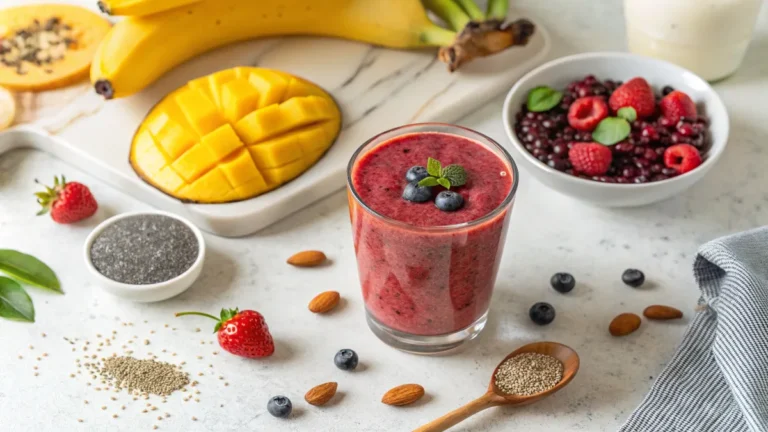
Fruit Smoothies No Yogurt: How To Make Creamy Smoothies Dairy-Free
Fruit smoothies no yogurt are the perfect blend of creamy texture and fruity flavor—without the dairy. Ideal for vegans, those with lactose intolerance, or anyone seeking a healthier, plant-based lifestyle.
- Total Time: 5 minutes
- Yield: 2 servings 1x
Ingredients
- 1 frozen banana
- 1 cup mixed berries
- 1 tbsp almond butter
- 1/2 cup oat milk
- 1 tbsp ground flaxseed
- 1 cup frozen mango
- 1/2 cup frozen pineapple
- 1/2 ripe avocado
- 3/4 cup coconut milk
- 1 tsp chia seeds (optional)
Instructions
- Start with the liquid base—pour oat milk or coconut milk into the blender first.
- Add soft fruits like banana or avocado.
- Layer in frozen fruits like berries, mango, or pineapple.
- Add almond butter, flaxseed, and optional chia seeds.
- Blend on low, then gradually increase speed until smooth.
- Adjust liquid for desired thickness.
- Pour and serve immediately or refrigerate for later.
Notes
Use a high-speed blender for best texture. Try freezing ingredients in advance for extra creaminess and convenience.
- Prep Time: 5 minutes
- Cook Time: 0 minutes
- Category: Smoothies
- Method: Blended
- Cuisine: Vegan
- Diet: Vegan
Nutrition
- Serving Size: 1 smoothie
- Calories: 210
- Sugar: 12g
- Sodium: 90mg
- Fat: 10g
- Saturated Fat: 2g
- Unsaturated Fat: 7g
- Trans Fat: 0g
- Carbohydrates: 28g
- Fiber: 6g
- Protein: 5g
- Cholesterol: 0mg
Keywords: fruit smoothies no yogurt, dairy-free smoothie, vegan smoothie, plant-based smoothie, healthy smoothie
All nutritional values and baking times are approximate and may vary based on ingredients, equipment, and altitude. Please adjust as needed.
Final Thoughts on Yogurt-Free Smoothie Lifestyle
One unexpected benefit of drinking fruit smoothies no yogurt is the digestive ease many people experience. Without the lactose, gums, or preservatives found in traditional yogurts, your gut gets a gentler ride—especially when you use fiber-rich ingredients like flax, chia, and fruit skins.
By now, you’ve learned that fruit smoothies no yogurt don’t mean compromising on flavor, texture, or health. You’ve got endless combinations to explore—from tropical blends to green energy boosters to protein-packed post-workout refuels.
Even more exciting is the creativity this dairy-free path unlocks. You can experiment with seasonal fruits, spice things up with cinnamon or turmeric, and discover new plant-based ingredients you never thought to blend. Plus, it’s easier on your wallet and your stomach.
Whether you’re lactose-intolerant, vegan, or just looking to eat cleaner, fruit smoothies no yogurt are a game-changer. Give them a try, and you’ll likely never go back to your old blender habits.
Don’t miss out on the flavorful and functional benefits of Gluten-Free Hamburger Helper—it’s a satisfying way to close out your smoothie lineup.
Add Chicken Smash Burger Tacos to your routine for a nourishing finish that ties your meal plan together beautifully.
Love learning how to make fruit smoothies no yogurt? Stay inspired and discover more delicious, dairy-free recipes by connecting with us on social media!
- Follow us on Facebook for daily smoothie ideas and kitchen tips: facebook.com/HestonRecipes
- Pin your favorite blends from our collection on Pinterest: pinterest.com/HestonRecipes2024
- Join the conversation on Twitter/X: twitter.com/HestonRecipes
Want even more inspiration for yogurt-free smoothies? Check out this delicious berry smoothie recipe that skips the yogurt but keeps all the flavor:
👉 Berry Smoothie No Yogurt – Two Raspberries

